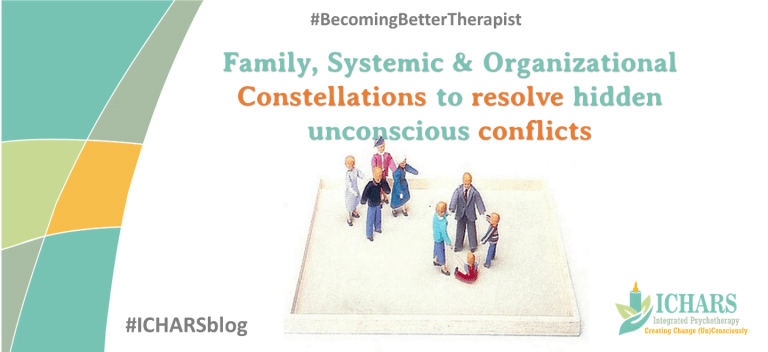Systemic and Family Constellation is a powerful tool to get insights on issues related to one’s personal and professional life. These insights lead to a shift in us, both at the level of conscious and unconscious. This shift helps us move closer to the resolutions which are in our best and highest interest.

Family and Systemic constellation was pioneered by German psychotherapist “Bert Hellinger”, who has also studied psychoanalysis, family therapy, gestalt therapy and transactional analysis. Hellinger’s innovative approach allowed the way for application of constellations to not just personal problems but also problems that occur within an organisation.
What is Constellation?
The word Constellation refers to a group or configuration of elements i.e. ideas, feelings, characteristics, objects, etc., that are related in some way. It is this relationship between the different elements of a system, that is at the heart of any problem. The problem can be related to any system be it an individual, a family or an organisation.
What is a System?

A system can be defined as an organised, purposeful structure that consists of interrelated and interdependent elements (components, entities, factors, members, parts etc.). These elements continually influence one another (directly or indirectly) to maintain their activity and the existence of the system, in order to achieve the goal of the system or to maintain an internal steady-state (called homeostasis).
An organisation is a system which contains different elements. These elements include management, investors, employees, values, missions, departments…
A family is a system that is a result of coming together of elements that include ancestors, parents, siblings, extended relatives, spouses, overall family values….
An individual is also a system made up of elements that can be conscious or unconscious like thoughts, feelings, emotions, beliefs, values, goals, skills, decisions…
In most cases these elements are highly influenced by past experiences which are a cause of many entanglements and conflicts between the elements. It is these entanglements and conflicts that may finally be leading to the presenting problem that the client is experiencing in his family, organisation or even at an individual level.
Now that you understand what a constellation and a system is, let us quickly look at how Family, Systemic & Organisational Constellation, can help in understanding and resolving a problem.
How does a constellation work?
Family constellation
Family constellation is a subjective therapeutic approach to unravel the hidden dynamic or layers that are part of one’s life, on which their values and beliefs may be based.
One may be consciously unaware of this information and the dynamics operating within their family, though it is the dynamics which may be the source of hindrance to their current problem or situation.
The constellation process provides an insight into this hidden dynamics and information which can eventually lead to resolutions.
Family Constellation works with Clients’ issues pertaining to any relationships or family matters, where in while setting up a constellation, the elements chosen would be from the client’s family, like his/her ancestors, parents, siblings, or any other member of the family.
Systemic constellation
In Systemic Constellation, we work with client’s issues pertaining to any emotions or internal conflicts, to understand the interplay of these elements within the client that may be leading to the problem.
Let me give you an example here, a client comes with the issue of confidence with respect to his work area. Here, the client can choose a representative for the self and another representative for confidence. These two elements will be used to setup the constellation.
Organisational constellation
Organisational Constellation, are used to work with organisational dilemmas like mergers and acquisitions, leadership issues, inter departmental conflicts, unrest amongst employees, organisational restructuring, recurring disturbing patterns amongst the functional team, culture change, inappropriate behaviour from the important member of the company etc. Similarly, in the organisational scenario, these elements are chosen to setup a constellation.
Process of Constellation (groups)
- A group is formed with around 10 or more participants, which is facilitated or led by the constellation facilitator.
- From amongst the group, one participant is picked up to work with their issue, whom we can call a client or a seeker.
- After a brief and factual interview with the facilitator, the key elements which become the basis on which the constellation is set up, are identified.
- The client is asked to intuitively select the representatives for the elements from the group members. All the other members of the group except the seeker and the representatives are called observers. If during the constellation, additional representatives are required, they are chosen from the observers. While the observers are not active participant of the constellation, they are playing the role of an objective observer who may as a part of the constellation get insights into their own problems and resolutions.
- Once the client has short listed the representative to represent specific elements in the constellation, the client will intuitively arrange these representatives in a position and at a place that feels right to them in the moment. The client chooses a place for himself or herself to sit and observe the interplay that happens between these elements.
- The representatives stand still and silent in their places for some time. Initially, unlike psychodrama, the representatives do not act, pose, dialogue or role play. The representatives are asked to connect to what is known as “the informing or knowing field”. The Knowing Field guides participants to perceive and articulate feelings and sensation that mirror those of the real family members or elements they represent. The representatives have little or no factual knowledge about those they represent. Nevertheless, the representatives usually experience feelings or physical sensations that very closely resemble those of the elements that are being represented.
- The facilitator may ask each representative to briefly report how they feel being placed in relation to the others. From here onward, based on the arrangement of the elements, their responses to the enquiries by the facilitator and the way these elements relate and interact with each other during the constellation, certain insights emerge. These insights along with the way the different elements move and re-position themselves during the constellation helps get clarity about the problem and the resolutions.
- At the end of the constellation, the client or the seeker is asked to stay with the insights and the learning from the constellation. Based on these insights, the client may need to make certain conscious actions to move towards the resolution. In many cases the client also notices certain shifts taking place in his thoughts, feelings and emotions unconsciously. These conscious actions and unconscious shifts help the client move towards their resolution.
Remember Family Constellation is an experiential process, what you are reading here is probably not even the tip of the iceberg. The real power of constellations can really only be understood when you have experienced it first-hand.

